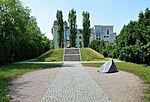Żegota Monument
1995 establishments in Poland1995 sculpturesHolocaust memorials in PolandMonuments and memorials in WarsawRescue of Jews by Poles in occupied Poland in 1939-1945

The Żegota Monument is a stone monument dedicated to the Żegota organization, which rescued Jews during the Holocaust in Poland. It is on Anielewicza Street in Warsaw in the Muranów neighborhood of Warsaw, Poland, near the Monument to the Ghetto Heroes and the POLIN Museum of the History of Polish Jews.
Excerpt from the Wikipedia article Żegota Monument (License: CC BY-SA 3.0, Authors, Images).Żegota Monument
Warsaw Śródmieście (Warsaw)
Geographical coordinates (GPS) Address Nearby Places Show on map
Geographical coordinates (GPS)
| Latitude | Longitude |
|---|---|
| N 52.249472222222 ° | E 20.994111111111 ° |
Address
Warsaw, Śródmieście (Warsaw)
Masovian Voivodeship, Poland
Open on Google Maps











